Potrebujeme váš súhlas na využitie jednotlivých dát, aby sa vám okrem iného mohli ukazovať informácie týkajúce sa vašich záujmov. Súhlas udelíte kliknutím na tlačidlo „OK“.
ASTM D6217-11
Standard Test Method for Particulate Contamination in Middle Distillate Fuels by Laboratory Filtration
Automaticky preložený názov:
Štandardná skúšobná metóda pre častíc kontaminácie stredného destilátu palív podľa Laboratory filtrácie
NORMA vydaná dňa 1.6.2011
Informácie o norme:
Označenie normy: ASTM D6217-11
Poznámka: NEPLATNÁ
Dátum vydania normy: 1.6.2011
Kód tovaru: NS-34262
Počet strán: 7
Približná hmotnosť: 21 g (0.05 libier)
Krajina: Americká technická norma
Kategória: Technické normy ASTM
Kategórie - podobné normy:
Anotácia textu normy ASTM D6217-11 :
Keywords:
diesel fuel, gravimetric determination, kerosine, laboratory filtration, membrane filter, middle distillate fuel, particulate contamination, Middle distillate fuels, Particulate contamination (petroleum), Distillate fuels, Gravimetric determination, Diesel engine fuel oils, Kerosine, Laboratory filtration, Membrane filters (MF), ICS Number Code 75.160.20 (Liquid fuels)
Doplňujúce informácie
| Significance and Use | ||||||||||||||||||||||||||||||||||
|
This is the first ASTM standard test method for assessing the mass quantity of particulates in middle distillate fuels. Test Method D5452 and its predecessor Test Method D2276 were developed for aviation fuels and used 1 gal or 5 L of fuel sample. Using 1 gal of a middle distillate fuel, which can contain greater particulate levels, often required excessive time to complete the filtration. This test method used about a quarter of the volume used in the aviation fuel methods. The mass of particulates present in a fuel is a significant factor, along with the size and nature of the individual particles, in the rapidity with which fuel system filters and other small orifices in fuel systems can become plugged. This test method provides a means of assessing the mass of particulates present in a fuel sample. The test method can be used in specifications and purchase documents as a means of controlling particulate contamination levels in the fuels purchased. Maximum particulate levels are specified in several military fuel specifications. |
||||||||||||||||||||||||||||||||||
| 1. Scope | ||||||||||||||||||||||||||||||||||
|
1.1 This test method covers the determination of the mass of particulate contamination in a middle distillate fuel by filtration. This test method is suitable for all No. 1 and No. 2 grades in Specifications D396, D975, D2880 and D3699 and for grades DMA and DMB in Specification D2069. 1.2 This test method is not suitable for fuels whose flash point as determined by Test Methods D56, D93 or D3828 is less than 38°C. Note 1—Middle distillate fuels with flash points less than 38°C have been ignited by discharges of static electricity when the fuels have been filtered through inadequately bonded or grounded membrane filter systems. See Test Methods D2276 and D5452 for means of determining particulate contamination in Specification D1655 aviation turbine fuels and other similar aviation fuels. See Guide D4865 for a more detailed discussion of static electricity formation and discharge. 1.3 This test method has not been validated for testing biodiesel, such as meeting Specification D6751 or blends of middle distillates and biodiesel, such as meeting Specification D7467, or both. Test Method D7321 has been determined to be suitable for testing B100 and all blends of middle distillates and biodiesel. Note 2—No. 1 and No. 2 grades in Specifications D396 or D975 currently allow up to 5% biodiesel meeting Specification D6751. Samples containing biodiesel can result in partial dissolution or compromise of the membrane filters and give erroneous results. 1.4 The precision of this test method is applicable to particulate contaminant levels between 0 to 25 g/m3 provided that 1 L samples are used and the 1 L is filtered completely. Higher levels of particulate contaminant can be measured, but are subject to uncertain precision. 1.5 The values stated in SI units are to be regarded as standard. No other units of measurement are included in this standard. 1.6 This standard does not purport to address all of the safety concerns, if any, associated with its use. It is the responsibility of the user of this standard to establish appropriate safety and health practices and determine the applicability of regulatory limitations prior to use. |
||||||||||||||||||||||||||||||||||
| 2. Referenced Documents | ||||||||||||||||||||||||||||||||||
|
Podobné normy:
Historická
1.11.2012
Historická
15.2.2010
Historická
1.5.2014
Historická
1.11.2012
Historická
1.5.2010
Historická
1.5.2010


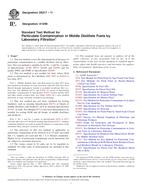
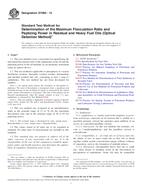 ASTM D7060-12
ASTM D7060-12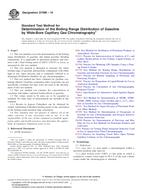 ASTM D7096-10
ASTM D7096-10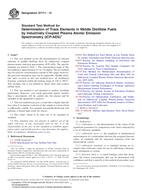 ASTM D7111-14
ASTM D7111-14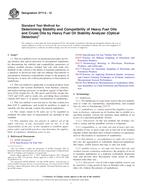 ASTM D7112-12
ASTM D7112-12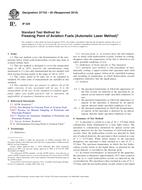 ASTM D7153-05(2010)..
ASTM D7153-05(2010)..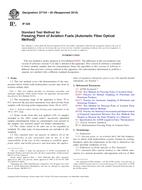 ASTM D7154-05(2010)..
ASTM D7154-05(2010)..
 Cookies
Cookies
